
Bella intervista! Mi trovo d'accordo nella valutazione di Keyper in 2 giocatori, che trovo comunque molto godibile.

Anche quest'anno proponiamo le interviste per gli autori dei giochi selezionati per il Goblin Magnifico. Quale miglior inizio se non il vincitore, Richard Breese? In attesa di vederlo a Play 2019 godetevi le rituali 10 domande a...
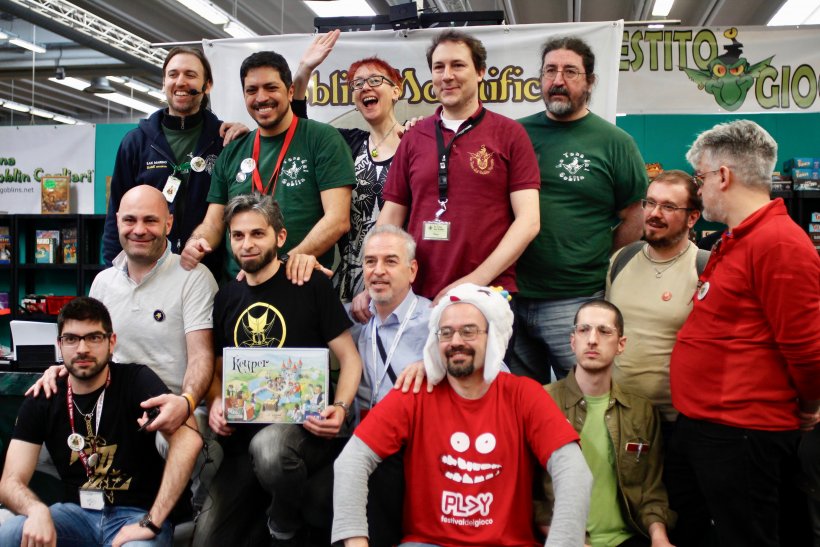
Di lavoro faccio il contabile e ho iniziato dal 1989 ad ideare e pubblicare giochi da tavolo in Gran Bretagna con la mia compagnia R&D games. Attualmente vivo a Stratford upon Avon. Sono principalmente conosciuto per la famiglia di giochi della serie “K” e altri giochi come Aladdin’s Dragons, Inhabit the Earth, Reef Encounter. Fino al 2015 mia sorella Juliet ha fatto da disegnatrice per i giochi della R&D, ora il ruolo è stato preso da Vicky Dalton.
Sono un’entusiasta eurogamer. Mi piacciono giochi simili a quelli che progetto io, come Marco Polo, Altiplano, Orléans e A Feast for Odin. Mi piacciono anche giochi introduttivi, come Century Spice Road, Azul e The Mind, oltre a degli astratti, come Ingenious, Rummikub and Abluxxen.
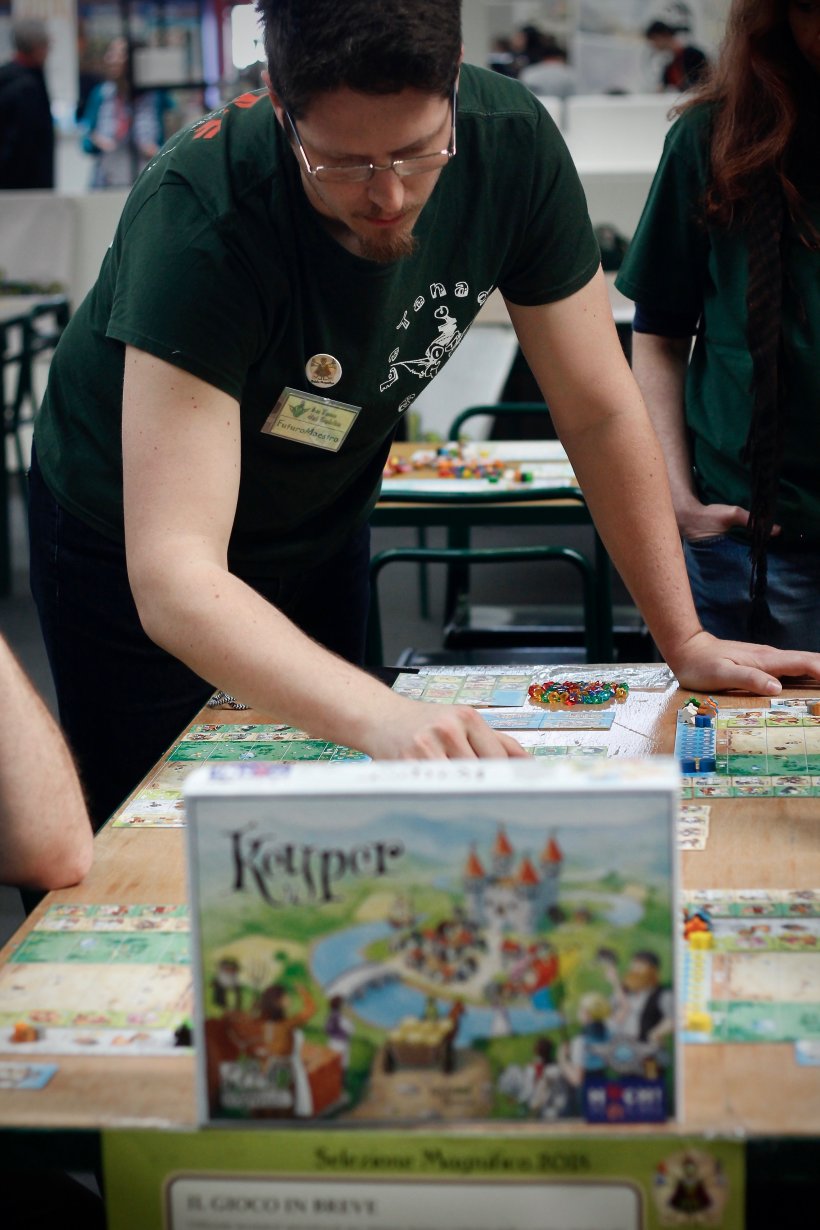
Quanto hanno in comune e quanto sono differenti i giochi della serie “K”?
Si vociferava che Aladdin’s Dragon potesse essere papabile per la lista dello Spiel des Jares, ma la giuria non ha apprezzato la scrittura del regolamento. Aladdin’s Dragon è una riedizione di Keydom, largamente riconosciuto come il primo gioco di piazzamento lavoratori, sarebbe stato un buon motivo per riservargli una migliore fortuna! Reef Encounter è un po’ noioso ed è un agnello travestito da lupo, che dovrò ripubblicare prima o poi!
Riguardo i giochi della serie “K”, tutti hanno dei tratti in comune. Sono giochi di piazzamento lavoratori. Non presentano interazione diretta (ad eccezione del primo della serie, Keydom) – l’interazione è prettamente indiretta. Le azioni sono positive, non distruttive – i giocatori creano qualcosa, non distruggono. C’è un tema medievale (a parte Key to the city – London, che è ambientato nel presente) che mostra un contesto amichevole – non c’è morte, combattimento, violenza. Sono tutti giochi differenti, ma, probabilmente, se te ne piace uno, ti piaceranno anche gli altri.
3) A molti giocatori non piace giocare a Keyper in 2 per come funziona la meccanica del “join”. Cosa ne pensi? Hai mai pensato a regole differenti per giocare in 2?
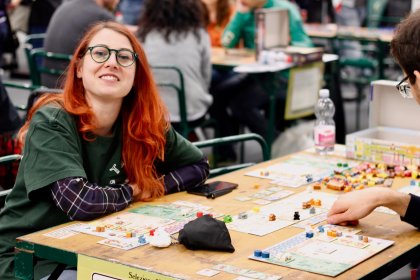
Keyper è stato a lungo playtestato in 2. Il gioco effettivamente gira in maniera diversa, ma penso che crei ancora un gioco interessante e stimolante, al punto di essere al momento il mio numero di giocatori ottimale! Le regole sono leggermente diverse, dato che si parte con lavoratore in più. Potrebbero non esserci molti join con giocatori alla prima esperienza, ma spesso può essere vantaggioso giocare aggressivamente sul join, con la conseguenza di avere più opportunità di stendere i lavoratori.
4) Un’idea centrale in Keyper è il mix dell’ “esclusione” tipica del piazzamento lavoratori (se io scelgo uno spazio azione, tu non puoi fare lo stesso) e l’ “inclusione” della meccanica del join (puoi beneficiare di una mai scelta). Come ti è venuta questa idea? Hai preso ispirazione da altri giochi?
In Keyper non c’è molta “esclusione”, dato che gli spazi azione sulle plance sono deliberatamente duplicati. Non amo molto i giochi che ti escludono la possibilità di fare determinate azioni. Non conosco altri giochi che hanno la meccanica di Keyper di “seguire” e “stendere” i lavoratori. L’ispirazione è venuta da una plancia pieghevole che ho visto ad una fiera. Ero convinto di poter ricavarne un gioco, ma ci sono voluti 3 anni di gestazione mentale per arrivare a qualcosa di appagante. Volevo che tutto fosse positivo, mi piaceva la meccanica che permette ai giocatori di trarre beneficio dal giocare i propri keyple velocemente e guadagnare turni. Quindi quando usi il “join”, non solo guadagni risorse extra e azioni extra, ma anche guadagni dei turni extra nella stagione (o riduci quelle dei tuoi avversari).
5) In Keyper ci sono tantissime tessere ed altrettanti modi per fare punti. Tuttavia un giocatore inesperto rischia di girare a vuoto, accumulando e trasformando risorse ma senza fare grossi punteggi. Riteniamo quindi che la definizione di point salad non sia adatta a Keyper. Sei d'accordo?
Ci vogliono un po’ di partite per familiarizzare con quello che c’è a disposizione e imparare ad ottimizzare i turni. È facile creare risorse e non usarle in maniera produttiva. Idealmente un giocatore dovrebbe sfruttare ogni risorsa che produce o ottiene. La chiave per giocare bene è prendere qualche tessera in primavera e giocare in loro funzione. Altrimenti giocatori inesperti possono annaspare per giocare gli ultimi turni dell’inverno in maniera produttiva. Il gioco tende a portarti, principalmente con la meccanica del “join”, dove non vuoi andare. Ma saper desistere è parte del suo divertimento.
La definizione “insalata di punti” non si può applicare a giochi che forniscono una varietà di modi per ottenere punti, ma che richiedono di concentrarsi su determinati aspetti. In Keyper è necessario focalizzarsi per fare un buon punteggio, quindi concordo col dire che Keyper non è un’insalata di punti, secondo questa definizione.
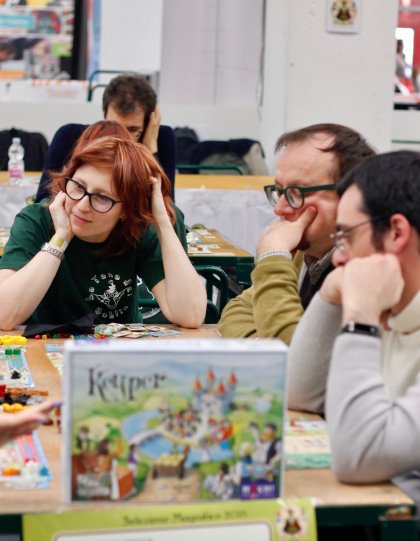
Ci ho pensato tanto. Per questo le plance si manipolano solo tre volte nel corso di una partita, alla fine della primavera, estate e autunno, inoltre la scelta è limitata a quattro alternative. Alcuni giocatori trovano divertente spiegazzare le plance, per altri non penso sia un problema doverlo fare tre volte nel corso della partita. In ogni caso le combinazioni possibili sono riportate nel manuale.
7) Hai annunciato la prima prima espansione per Keyper: cosa aggiunge al gioco? Anche Keyflower ha avuto varie espansioni. Qual è la tua opinione in merito? Pensi che le espansioni apportino novità ad un gioco e lo arricchiscano?
Si, penso che per Keyflower le espansioni apportino nuove idee e, particolarmente per Merchants, lo rendano un gioco migliore e più appagante, dato che si aggiunge un nuovo modo per ottenere le risorse, mediante i contratti, che sarebbero difficili da ottenere, e si aggiunge anche maggiore profondità dato che gli edifici si possono sviluppare una seconda volta.
L’espansione di Keyper non è ancora completata, presumibilmente avrà un approccio modulare. Come prima cosa ci sono nuove tessere edificio (country tiles), poi c’è una nuova plancia comune (country board) con l’introduzione della pesca, con dei pezzi in legno per i pesci, nuove tessere e una nuova plancia del “Pesce Fresco”. Terza cosa c’è una plancia per le stagioni che introduce lo strambo concetto di stagioni non simultanee per i giocatori. Infine ci sono delle tessere piuttosto estreme chiamate Leader e Partner.
8) Kickstarter, Legacy, applicazioni per SmartPhones. Tre cose che sembrano invadere e cambiare il mondo dei giochi da tavolo. Hai un parere positivo o negativo su ciascuno di essi?
Ho una posizione favorevole rispetto a Kickstarter, che ho utilizzato per l’edizione speciale “Character” di Keyper, più per valutare la richiesta che per necessità di ricavare fondi. Le mie preferenze per i giochi vanno agli eurogame rigiocabili, per questo non ho provato molti legacy, anche se le cose potrebbero cambiare.
Infine, lavoro nel campo della finanza e passo un sacco di tempo davanti allo schermo, e lo stesso vale per il lavoro di grafica alla R&D games. Pertanto lascio volentieri ad altri i giochi elettronici e lo sviluppo di versioni elettroniche dei miei giochi. A me piace giocare faccia a faccia.
9) Hai giocato gli altri sette selezionati del nostro premio? Cosa ne pensi?
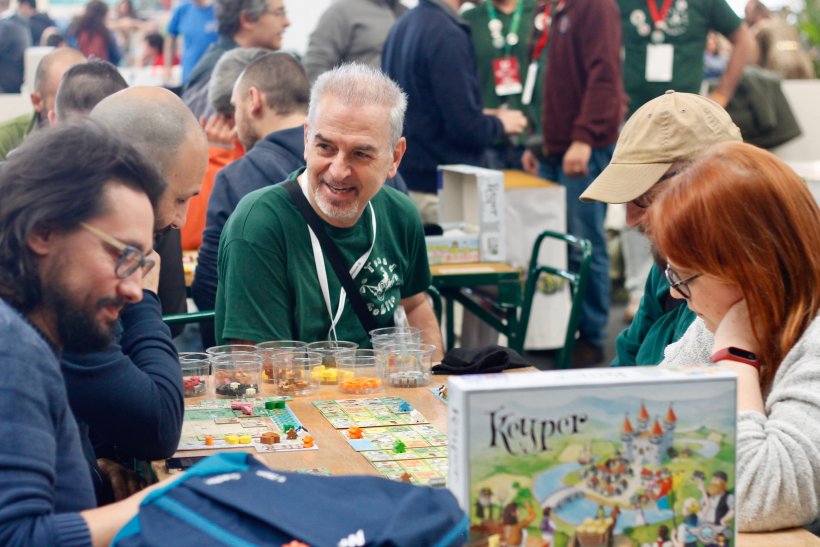
La lista degli 8 dimostra quale sia il livello dei giochi ogni anno pubblicati. Uno scenario totalmente diverso rispetto a quando ho iniziato, nel 1989, sia per qualità che per quantità. Degli altri 7 quello che preferisco è Heaven & Ale. Ha tante idee interessanti e si avvicina al tipo di giochi che mi piace giocare e pubblicare. Di poco staccato c’è Gaia project, che apporta delle interessanti novità al suo predecessore Terra Mystica ed è meno restrittivo, cosa per me positiva.
10) A quali nuovi giochi stai lavorando? Raccontaci un po’ dei progetti futuri.
Il nuovo gioco per Essen 2018 ha come co-autori Sebastian Bleasdale, Ian Vincent; si chiama Key Flow ed è un card-driven basato su Keyflower. Il gioco” scorre” (“flow”) velocemente attraverso 4 round (stagioni), nel quale I giocatori sviluppano il proprio villaggio, con tanti modi per fare punti per edifici, animali, lavoratori, risorse ed altro. Il prototipo ha ricevuto buoni consensi e sono pronto a presentarlo ad Essen.
Sto anche pianificando una re-implementazione di Key Market per il fine 2018/inizio 2019 e, come detto, per la prima espansione di Keyper, probabilmente prevista per Essen 2019. I miei giochi richiedono come minimo un paio di anni di sviluppo, per questo il gioco per il 2020 sta già prendendo forma.
Grazie per il vostro interesse nella R&D Games e per aver assegnato il Goblin Magnifico a Keyper.
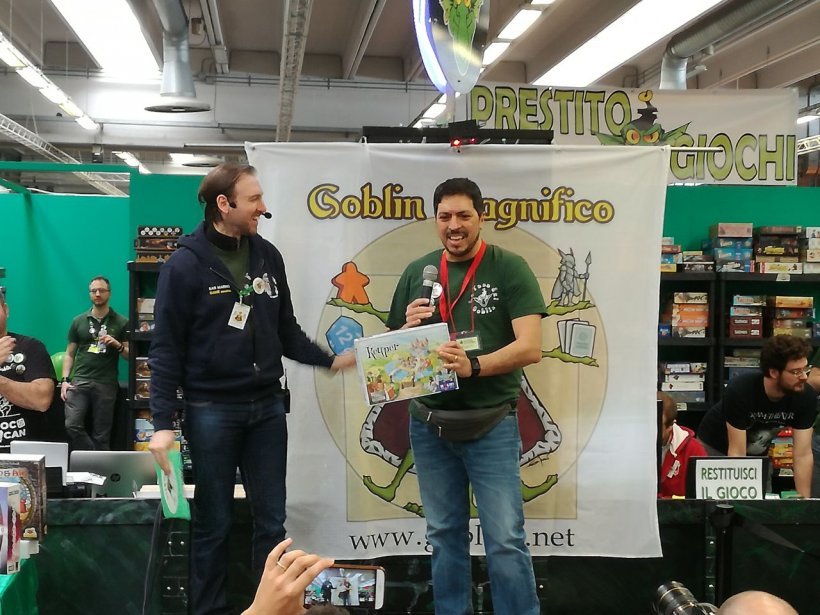
1) Tell us something about you: what kind of player are you? Tell us your favourite games (not made by you).
I’m an accountant by profession and I’ve been designing and publishing games in the UK through my own company R&D Games since 1989. I currently live in Stratford upon Avon. I’m best known for the Key series family of games as well as other games such as Aladdin's Dragons, Inhabit the Earth and Reef Encounter. Until 2015 my sister Juliet was the artist on the R&D games, a role now handed over to Vicky Dalton.
I’m an enthusiastic Eurogamer. I enjoy games similar to my own, such as Marco Polo, Altiplano, Orléans and A Feast for Odin. I also enjoy gateway games such as the recent games Century Spice Road, Azul and The Mind plus other abstract games such as Ingenious, Rummikub and Abluxxen.
2) Keyper won Goblin Magnifico, is there another game in your collection that you think would have deserved more luck? And Why?
It was rumoured that Aladdin’s Dragons was a close contender for the Spiel de Jahres shortlist, but that the rule book was not a favourite of the jury’s. Aladdin’s Dragons was a re-issue of Keydom, which is widely recognised as the first worker placement game, which would have been a good reason to have deserved a little more luck! Reef Encounter was a little bit of a sleeper and a sheep in wolf’s clothing which I need to re-issue at some point!
How much do the "K" series games have in common and how different are they?
The ‘Key’ games all have the following traits. They are all worker placement games. There is no direct player interaction (with the exception of the first key game Keywood) – the interaction is indirect through the game mechanisms. Actions are positive, not destructive – players are creating something, not destroying something. There is a medieval theme (except Key to the City – London, which is set in the present time) which is presented in a family friendly way – there are no deaths or any violence or combat. Each game is a stand-alone game, but if you enjoy one you will likely enjoy the others.
3) Many players do not like playing Keyper with 2 players, due to peculiarity of the “join” mechanism. What do you think about it? Have you ever thought about different rules for playing with 2 players?
Keyper was play tested a lot of times with 2 players. The game does play differently with 2 players, but I do think it still creates an interesting and challenging game with that number, which I think is actually my favourite player number! The rules are marginally different, as each player starts with a different ninth keyple, giving each player a different planning and joining opportunity. There may not be as much joining with newer players in the 2 player game, but often it can be advantageous to join aggressively with the advantage of more lay downs as a consequence.
4. A core idea of Keyper is the mix of typical worker placement exclusion (if I chose an action space you cannot do the same) and the inclusion for the join mechanism (you can benefit for my choice). How did you get this idea? Did you get inspired by other games?
In Keyper there is not a lot of exclusion, as the field spaces on the country boards are deliberately duplicated. I am not keen on games which prevent some players from taking certain actions. I had not previously encountered the joining and laying down mechanisms. They flowed through from the initial folding board which I discovered as an advertising aide at a trade show. I was convinced there was a game there, but it took about three years of mental gestation to arrive at some mechanics I was happy with. I wanted everything to be positive, and also liked the mechanic that allows players to benefit from playing their keyples quickly and gaining extra turns. So when you join, not only do you get extra resources or actions, but you also gain an extra turn later in the season (or reduce those of your opponents).
5. In Keyper you have many tiles and many ways for victory points. However you often see an inexperienced player wasting time producing and converting resources without making many points. “Point salad” is not a correct term for Keyper, do you agree?
It takes a few games familiarise yourself with what is available and to learn to use your turns optimally. It is easy to create resources and not to use them productively. Ideally a player should have a use for every resource they create or obtain. The key to doing well at the game is to acquire some of the spring country tiles and to play towards those. Otherwise inexperienced gamers can find that they struggle to use their last few turns in winter very productively. The game has a habit, mainly through the joining mechanism, of leading a player somewhere they don’t really want to go. But knowing when to resist that is part of the fun of the game.
A ‘Point salad’ definition says that it does not refer to are games that provide a variety of ways to get points but are otherwise very focused. In Keyper you have to stay focused to get a good score so I would agree that Keyper is not a point salad in that definition.
6. Folding country boards are a nice innovation, but they involve a waste of time to choose the right combinations. This is opposed to the modern trend to avoid dead times in complex games. Did you think about this issue?
I gave a lot of thought to this issue. That is why in the game you only manipulate the board three times, at the end of spring, summer and autumn and also, on each occasion, the choice is restricted to only four different alternatives. In addition players manipulate the boards simultaneously, which minimises the down time. For many players the manipulation is fun and for the others I don’t think three times in the game with simultaneous play is excessive or a problem. And in any event the ‘answers’ (permutations) are given in the rule book.
7. The first expansion for Keyper has already been announced: what does it add to the game? Keyflower also had various expansions. What is your opinion about this item? Do you think expansions bring newness to the game and enrich it?
Yes, I think the Keyflower expansions bring both new ideas to explore and, particularly with Merchants, make it a better and more fulfilling game as it adds a new way through the contracts to get resources which can otherwise be difficult to obtain and also adds greater depth as buildings can be developed a second time.
The Keyper expansion is not yet finalised, but is likely to take a modular approach. First, there are new country tiles. Secondly there is a new country board and the introduction of fishing, with wooden fish, new tiles and a new ‘Fresh Fish’ board. Thirdly there is a season board which introduces the rather mind blowing concept of non-coterminous player seasons. Then fourthly there are some rather extreme country tiles known as the Leader and the Partner.
8. Kickstarter, Legacy System, Smart Phones’ Apps. Three things that seem invading and changing the world of boardgaming. Do you have a positive or negative opinion about each of them?
Kickstarter I used for the Keyper Character Edition, more to gage demand than to raise funds. So that was a positive. My gaming preference is re-playable Eurogames so I have not played many legacy games, but that may change. The development I think is an interesting one.
I also have a finance job which includes much screen time, as does my R&D graphics work. So I am happy to leave electronic games and electronic copies of my games to others. My preference is to play games face to face.
9. Did you play the other seven games in the selection? What do you think about them?
The eight games shortlisted demonstrate what a great selection of new games are now published each year. Such a far cry from when I started publishing in 1989, both in quantity and quality. From the other seven: Aeon's End, Gaia Project, Heaven & Ale, Noria, Pulsar 2849 and Time of Crisis, Heaven and Ale was my favourite. It had a lot of nice ideas and is closest to the games I like to play and publish. Gaia Project was a close second and includes some nice improvements on its predecessor Terra Mystica and is less restrictive which I think is a positive.
10. What new games are you working on? Tell us something about your future projects.
The new game for Spiel 2018 is a co-design with Sebastian Bleasdale and Ian Vincent called Key Flow, which is a card-driven game based on many of the ideas contained in Keyflower. The game ‘flows’ quickly over four game rounds (seasons), allowing players to develop their own unique village, with many ways to score points for their buildings, animals, keyples, resources and other items. The proto-type game has been very positively received and I’m looking forward to demonstrating it in Essen.
I’m also planning a re-issue of Key Market at the end of 2018/early 2019 and, as mentioned, a Keyper expansion, probably at Spiel in 2019. My games generally take at least a couple of years from conception and the 2020 game is also taking shape in the background.
Thanks for your interest in R&D Games and thank you again for choosing Keyper as the 2018 Goblin Magnifico.
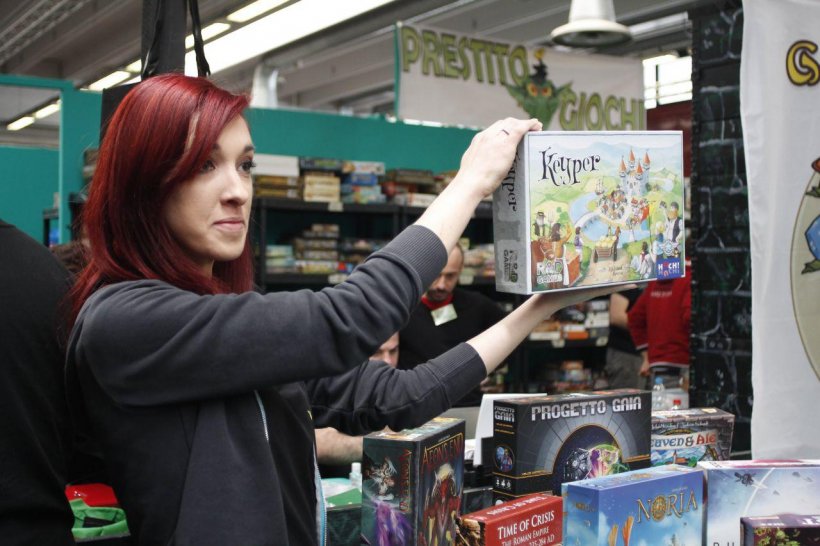

Bella intervista! Mi trovo d'accordo nella valutazione di Keyper in 2 giocatori, che trovo comunque molto godibile.
interessante, penso che abbia avuto il giusto coronamento di una serie di ottimi giochi fatti.
Lo aspettiamo a Play:)
Ottima la notizia di una reimplementazione di Key Market che è introvabile!
Bella intervista e ottimi gusti il nostro Breeze
Breese uno tra i miei autori preferiti, lo aspetto a Play per farmi firmare tutti i suoi giochi che ho in collezione, che non sono neanche pochi...
Per scrivere un commento devi avere un account. Clicca qui per iscriverti o accedere al sito
Accedi al sito per commentare© 2004 - 2023 Associazione Culturale - "TdG" La Tana dei Goblin
C.F./P.IVA: 12082231007 - P.le Clodio 8, 00195 Roma
Regolamento del sito | Archivio | Informativa privacy e cookie | Contatti
La Tana dei Goblin protegge e condivide i contenuti del sito in base alla seguente licenza Creative Commons: Attribuzione - Non Commerciale - Condividi allo stesso modo, v.4.0. Leggi il testo sintetico, oppure il testo legale della licenza.